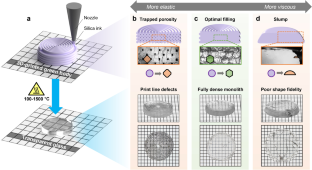3D printing of void-free glass monoliths: rheological and geometric considerations
Abstract
Direct ink writing (DIW) is a versatile additive manufacturing technique capable of printing 3D architectures from a broad range of materials. The key advantage of DIW is the ability to spatially control both the architecture and the composition of the printed part, which enables the production of components with previously unachievable combinations of functionalities. One emergent application space for DIW has been in additively manufactured glass optics, where a “green body” is patterned layer-by-layer by extruding a silica-based slurry through a microfluidic nozzle and then thermally consolidated to transparent glass. A critical aspect of the process is ensuring that the printed part is completely free of voids that can occur in the interstitial spaces between the extruded filaments. This outcome is governed by the interplay between ink rheology and strains imposed by the printing process and geometric packing of the filaments. Here, we explore the strain- and rate-dependent deformation events in the DIW process to determine conditions that enable the printing of void-free monoliths without sacrificing shape fidelity. We focus on yield stress fluids consisting of fumed silica nanoparticles dispersed in organic solvents at varied volume fractions to control the rheological properties. We investigate the printability of these ink materials as a function of print process variables and devise the appropriate dimensionless parameters that capture the geometry-dependent and rate-dependent effects on the deformation of the extruded ink. Finally, we use these scaling arguments to construct a phase diagram for void-free monolith printability.
Graphical abstract


 求助内容:
求助内容: 应助结果提醒方式:
应助结果提醒方式:


